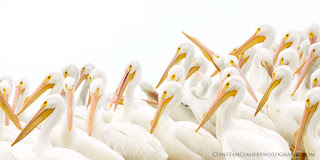It is that time of year when I look forward to the arrival of my favorite snowbird; you know the large white one with a rotund torso supported by very short legs, black tipped wings and a long orange beak. Finally, a cold front hit south Florida, breaking the abnormal period of summer-like temperatures, and with it came the white pelicans. The cold front brought high winds, keeping me on land all weekend. But it was when I was standing on Chokoloskee Island that I looked up at the cloud covered sky to see my first flock of white pelicans of the season. At last! As I watched a flock of twenty soar over me, I momentarily forgot the el Nino forecast of a wet and windy camping season. My first siting of the pellies is a turning point as I begin to anticipate another season of paddling and camping in the Everglades.
If the dolphin pods slicing through the gulf waters symbolize the water experience of the Everglades, the white pelicans with their high wing aspect ratio (wing length squared divided by wing surface area) and ability to soar for hours symbolize everything above the Everglades water. If you spend any time in the gulf waters of the Ten Thousand Islands, the very large back country bays or Florida Bay, you know that the Everglades equals sky plus water, and not much in between the two. Study the water and you will observe marine life of all sorts, tarpon, spotted rays, loggerhead turtles, cormorants, manatee and so on. But look up and you will observe the white pelican, massive with its 10-ft wing spread and even more impressive when you see hundreds of them swirling on the air thermals. They move through the sky by flying in circles, and appear as quickly as they disappear into the vastness of the sky.
White pelicans love to roost on the flats. If you see one, you see dozens. It is sheer delight especially when you spot the crowd a mile away. Their white lumbering bodies provide a brilliant background for the bright orange beaks and legs. I love filling the frame with white pelicans!
Rarely have I encountered a single white pelican but it has happened twice, once on Biscayne Bay and another time on Chokoloskee Bay. Both encounters occurred in the ripeness of summer. The Biscayne Bay bird may have been a juvenile, too young to fly north and mate. On Chokoloskee Bay, the lone bird appeared sick, or perhaps it was just old age and not worth the trouble to fly north. Instead, the bird spent its summer on the bay with the active roseate spoonbills, biding its time. I titled this image "Life Goes On".
Soon, I will be packing my tent and gear to head out camping in the Everglades. I hope to take many trips during the next few months and see hundreds more white pelicans. There are many good reasons to be in the Everglades in the summer (and just as many reasons not to be!), but it is during the winter that it seems full of vigor after several groggy months of heat. This is when I love to be out there paddling for hours on end. The water sparkles from a cloudless sky that is active with birds and it never gets old. Words cannot express the feeling of ending the day under an Everglades sky, and to wake up and watch it greet you again with beautiful wings flying across the horizon the next day. The winter Everglades sky belongs to the white pelicans and they are back.









